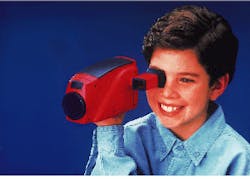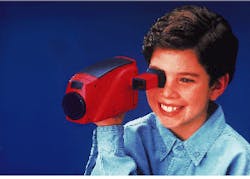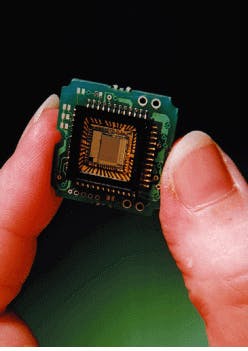Low-cost sensors spawn imaging-based toys
Low-cost sensors spawn imaging-based toys
Single-chip integrated camera systems offer reduced size, cost, and power consumption, promising a variety of new consumer applications.
Ian T. Muirhead
We have all been exposed to the toy industry at some stage of our lives--if only as consumers. For most of us the experience ended with our last Action Man, Barbie doll, Matchbox car, or perhaps--if you are young enough or young at heart--a Nintendo or Sega video game. But new generations of children will expect even more-sophisticated toys and games, and there is a multibillion-dollar industry out waiting to satisfy them.
Both electronics and optoelectronics technologies have played major roles in the toy industry for many years and have spawned a whole group of businesses separate from the more-traditional toy sector. An obvious example of this is Nintendo, which evolved from its corporate roots supplying playing cards in the earlier part of this century. Nonetheless, as the video-games market moves toward increasingly complex graphics that require ever more computing power, the traditional toy sector is not about to be left behind. The age of the "traditional video toy" is now with us.
At the 1996 February Toy Fair (New York, NY) two major imaging-based toys were announced--the Tyco VideoCam and the Fisher Price Creative Effects Camera. The former, voted "Toy of the Year" in a number of countries, is a video camera for children that uses international-video-standard EIA/CCIR monochrome imaging devices to record onto standard videotape or playback directly to a television (see Fig. 1). With the VideoCam, children can make home movies without touching the family camcorder.
The Fisher Price camera takes a black-and-white photograph and prints the image onto thermal paper--an instant camera for children. But the fun does not stop there. A picture taken with the camera can be framed within the image of a dollar bill, a TV screen, or with a speech bubble attached that can later be colored in with vivid effect. A budding young photographer can create a story book using a series of these images.
A price-sensitive market
Imaging devices are not new, and the technology involved with these toys to date--charge-coupled devices (CCDs)--has been around for some time. So why has it taken so long for vision-based toys to appear?
The toy market is a highly price-sensitive, fast-moving, and high-volume consumer goods market. Until recently, video products (image-sensing-based as opposed to computer-based) have apparently been inhibited by the price of CCDs. In the late 1980s Fisher Price introduced the Pixel 2000, a toy that used a black-and-white low-resolution CCD and recorded about 20 min. of motion video onto industry-standard audio cassette tape. Although the product reached a certain cult status when one of the New York film festivals devoted an entire section to films produced on this medium, the Pixel 2000 was eventually withdrawn from the market. The price of the CCD component played a role in this. Price is king in much of the toy industry.
Charge-coupled devices have been the mainstay of solid-state imaging for many years and have wide industrial applications. Until now, however, the primary consumer application has been camcorders. Device manufacturing technology is specialized but makes use of a single-channel metal-oxide semiconductor (MOS) silicon process to produce the imaging array. The peripheral components, such as timing signals to produce a video-standard NTSC camera, must be generated by separate chips. At least two are typically required in addition to the CCD sensor itself. This leads to additional manufacturing process time and several discrete components.
CMOS device technology
The major breakthrough that enabled video-based toys to become viable was fabrication of the imaging array in a standard complementary MOS (CMOS) process with the additional functions "on-chip" to give a single-chip camera solution (see Fig. 2). The beauty of CMOS imaging technology is that sensors can be made on chips fabricated by commodity-oriented, high-volume processes. These are the same silicon foundry lines that produce the ubiquitous microprocessor and more than 90% of all modern electronic products.
Given that the imaging part is a routine block to be integrated on a CMOS chip, it is both feasible and highly desirable to add the remaining system electronics to the same chip. This level of integration reduces manufacturing costs for a camera system and leads to imaging devices of lower cost, smaller size, and reduced power consumption that are highly applicable for consumer applications. These benefits closely match the requirements of any toy manufacturer as well as parents. Both the toys described earlier apply CMOS imaging devices instead of CCDs.
Imaging devices are, however, only half the vision toy. The image must be displayed somewhere, and truly low-cost technology has yet to make its mark in display systems. Hence, early vision toys will make use of existing television and video cassette recorders. A majority of homes have these devices so the display technology is already installed. Video-game consoles and personal computers may be the next readily available display base but more-mobile vision toys with fully integrated displays may have to wait until flat-panel and liquid-crystal displays become sufficiently low cost.
Toys, of course, are not just about technology. In many ways they are fashion items and are subject to similar whims. The power of marketing through promotion and distribution is of paramount importance in this industry. This year`s "must-have" item could be in the back of the cupboard next year. The secret for a toy company is to find a product that appeals to each new generation of children. The challenge for the imaging manufacturer is to produce a device at the right quality/price point, while matching the build requirements of a highly cyclical market.
Toys that see
The use of imaging devices in consumer toys has just begun, starting with the more obvious ventures of making versions of adult products for children. The newest video toys are black-and-white but consumers will undoubtedly be hungry for color--if it can be achieved at the right price.
In the future all manner of toys may be able to "see;" cars, airplanes, submarines, Barbie dolls, even Action Man. Applications will be limited only by the imagination of the toy designer. As toys, video games, virtual reality, and personal-computer media communications continue to blend, we will no longer be talking about imaging devices in toys but purely of imaging and the world of entertainment. It sure sounds like a lot of fun whether you are five or ninety-five! o
FIGURE 1. Voted "Toy-of-the-Year" in many countries, the Tyco VideoCam child-size video camera records monochrome motion video onto standard videotape or outputs directly to a television.
FIGURE 2. Fully integrated single-chi¥CMOS-based cameras have opened u¥new applications for low-cost video imaging, including toys.


